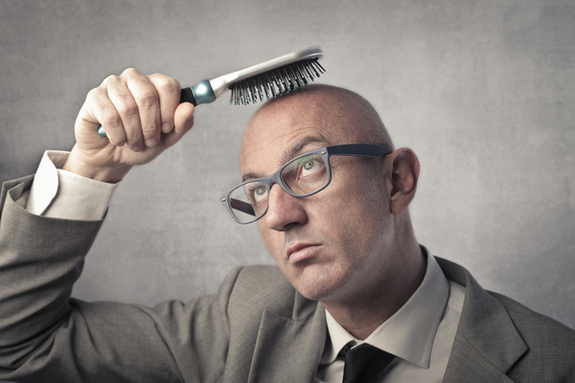
 Symptoms of Hairloss
Symptoms of HairlossDifferent types of hair loss have different symptoms. Sometimes, both the head and body can be affected.
Male-pattern baldness usually starts around the late twenties or early thirties. By their late thirties, most men have some degree of hair loss.
Male-pattern baldness is so called because it generally follows a set pattern. The first stage is usually a receding hairline, followed by thinning of the hair on the crown and temples. This can leave a horseshoe shape of hair around the back and sides of the head. Sometimes it can progress to complete baldness, although this is uncommon.
Women's hair gradually thins with age, but women generally lose hair from the top of their head only. This is usually more noticeable after the menopause (when a woman's periods stop at around 52 years of age).
Alopecia areata causes patches of baldness about the size of a large coin. They usually appear on the scalp but can occur anywhere on the body.
There are usually no other symptoms, although in around one in 10 people the fingernails may also be affected, and may have a pitted or grooved appearance.
In most cases of alopecia areata, hair will grow back in a few months. At first, hair may grow back fine and white, but over time it should thicken and regain its normal colour.
Some people with alopecia areata go on to develop a more severe form of hair loss, such as:
As scarring alopecia is caused by another health condition, you will have symptoms relating to this condition besides hair loss. Unlike other forms of hair loss, the skin where the hair has fallen out is likely to be affected in some way.
For example, in cases where lichen planus has caused scarring alopecia, the skin may develop an itchy rash and may be inflamed.
In scarring alopecia, the hair follicles (small holes in the skin that contain the roots of each hair) are damaged and replaced with scar tissue. This means that new hair cannot grow, so the hair loss is permanent.
Anagen effluvium, most commonly caused bychemotherapy, usually occurs quickly. In most cases, hair loss is noticeable within a few weeks of chemotherapy starting. In anagen effluvium, hair loss is widespread, rather than in patches. As well as losing hair from your scalp, you may also lose hair from your body and face.
This type of hair loss is usually temporary. Your hair should stop falling out and start to grow back a few months after chemotherapy has stopped.
In telogen effluvium, there is widespread hair loss from your scalp, rather than specific bald patches. Your hair may feel thinner than before, but you are unlikely to lose it all. Your other body hair will not usually be affected.
In most cases of telogen effluvium, your hair will stop falling out and start to grow back within six months.
We help you make your trip to Turkey as easy and hassle-free as possible. We offer free airport transfers from/to the airport with English speaking guide. We take care of arranging your accommodation for night of your hair transplantation. We will be happy to meet with you to discuss any questions you may have about a hair transplant in Turkey. Free Consultation...
For information about the latest and most modern fue hair transplant and hair loss treatment available, schedule your no-obligation consultation with Dr. Keser today. - Learn More about FUE...